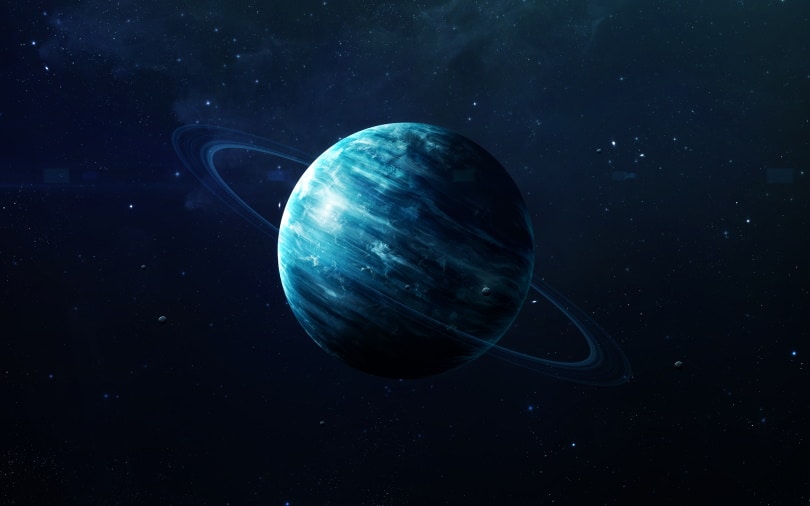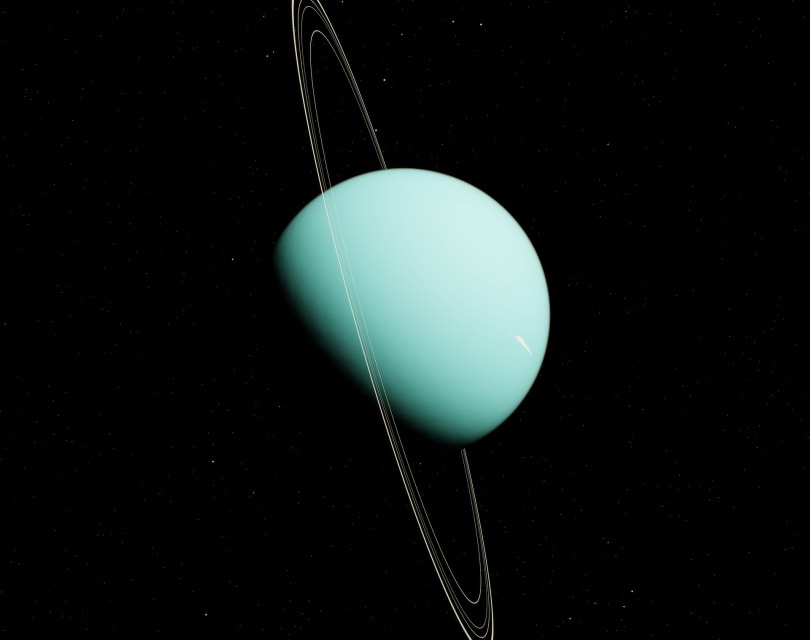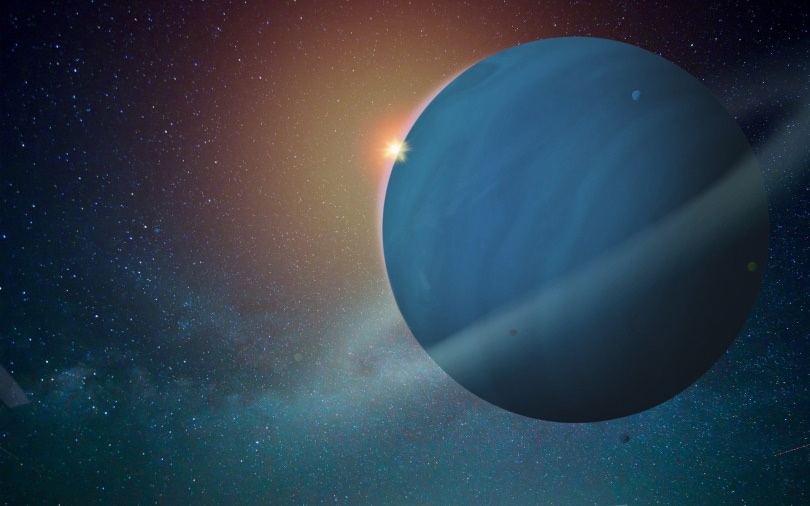What Color Is Uranus? What Are True & False Colors?
Last Updated on

When it comes to the planets, it isn’t always easy to know what color each one is. So, what about Uranus? Uranus is blue-green in color. However, planetary colors can change depending on factors, such as the angle of view and different lighting conditions. So, while Uranus may typically appear blue-green, it could look somewhat different at times.
The phenomenon is loosely referred to as “true and false colors.” In this guide, we explain the color of Uranus in detail.

True and False Colors of Uranus
Sometimes, you can see two pictures of Uranus taken by NASA. The most popular images were taken using Voyager 2’s narrow-angle camera with the spacecraft being 9.1 million kilometers or 5.7 million miles away from Uranus.
Pictures of Uranus are sometimes taken through orange, green, and blue filters. The dark shading on the top of the planet’s disk shows the day-night boundary.
The planet’s northern hemisphere is beyond the day-night boundary. As a result, it is immersed in darkness during the planet’s rotation. The planet’s blue-green color is due to methane in its atmosphere.
The methane absorbs red light, leading to the planet giving off a blue-green color.
Other popular pictures are processed through contrast enhancement to make the planet’s polar regions more detailed. NASA took pictures through orange, violet, and ultraviolet filters, converting them to red, blue, and green colors. Thus, resulting in a false color to show the dark polar hood on Uranus. The polar hood is surrounded by concentric bands that are relatively lighter in color.

What Are True and False Planetary Colors?
When it comes to planets and their colors, two different types of colors can be seen. First, there is the true color, which is the color that the planet would be if there were no atmosphere. The second type is the false color, which is the color that the planet would be if there were an atmosphere.
We can see the colors of the planets in our Solar System using two different methods. The first method is by using a telescope, and the second method is by using photography.
When using telescopes, the colors seen are usually the true colors of the planets. That’s because telescopes allow us to see through the atmosphere of the planet. However, there are times when a planet’s atmosphere can cause the colors to appear different than they are.
The second method for seeing the colors of the planets is by using photography. Photography allows us to see the false colors of the planets. When taking pictures, the camera captures all the light reflecting off of the planet. In addition, it includes the light reflected off from the atmosphere.
The false colors seen in photographs are usually due to the different gasses in a planet’s atmosphere. For example, on Mars, the red color is caused by iron oxide dust in the atmosphere.
The Role of the Magnetosphere
The Magnetosphere refers to the region of space surrounding an astronomical object in which charged particles are affected by that object’s magnetic field.
It is a dynamic environment where the interplay between the solar wind, the planetary magnetic field, and the plasma in the magnetosphere creates conditions that can be both hazardous and beneficial to life on Earth.
The solar wind is a stream of charged particles (plasma) from the Sun that constantly flows outward into the solar system. When this plasma encounters a planet with a magnetic field, it is diverted around the planet.
The interaction between the solar wind and the planet’s magnetic field creates a cavity in the solar wind called the magnetosphere.
The magnetosphere protects Earth from the harmful effects of solar wind. However, it also traps some of the plasma from the solar wind within its confines. The trapped plasma interacts with the Earth’s magnetic field to create auroras and other phenomena.
Auroras are most often present in the polar regions, where the Earth’s magnetic field lines dip down toward the planet’s surface. As a result, the charged particles in the magnetosphere move toward these regions. Here, they collide with atoms in the upper atmosphere and release energy in the form of light.
Uranus has an irregularly shaped and unusual magnetosphere. The planet’s magnetic field is tilted about 60 degrees from its axis of rotation.
On Earth, the auroras are in line with the poles. The same goes for Saturn and Jupiter.

How Is Uranus Photographed?
Like most other planets, Uranus is photographed using a telescope. However, because Uranus is so far away from Earth, it can be challenging to get clear pictures.
The best way to photograph Uranus is to use a particular type of camera called an infrared camera. Infrared light is invisible to the human eye and can be used to take pictures of objects that are very far away.
Uranus is usually photographed by pointing a telescope at it and taking a long exposure, a picture taken over some time. It allows the camera to gather enough light to create a clear image.
According to NASA, Uranus is an “ice giant.” Thus, the planet lacks a solid surface. Instead, most of it is swirling fluids. Therefore, it would be impossible for a spacecraft to land on Uranus since there’s no surface.
Likewise, a spacecraft would not be able to fly through the planet’s atmosphere without getting destroyed. The temperature and pressure on Uranus are so harsh that they will destroy even a metal spacecraft.

Why Is Uranus Blue?
The atmosphere on Uranus has methane, helium, and hydrogen. The methane in Uranus’s atmosphere gives the planet its bluish color.
Methane is a gas made of carbon and hydrogen. It is present in small amounts in Earth’s atmosphere, but it is more common on Uranus.
Since methane is present in the planet’s upper atmosphere, it gets light from the Sun. It reflects the Sun’s blue light and absorbs the red light. As a result, the planet appears blue-green.
Are you wondering how the Sun gives off blue and red light? Well, sunlight comprises all the rainbow colors: red, orange, yellow, green, blue, and violet.
All these colors mix to form sunlight. However, when sunlight hits an object, some colors are absorbed while others reflect off. The colors reflected off an object determine the color that we see.
So, when sunlight hits Uranus, the blue light is reflected while the red light is absorbed. So, as a result, we see Uranus as a blue-green planet.
Similarly, Mars appears red because the planet’s atmosphere consists of dust particles that reflect red light. Meanwhile, Venus appears yellow because it has clouds of sulfuric acid that reflect yellow light.

Final Words
To sum it up, Uranus has a blue-green color due to the absorption of red light by methane in its atmosphere. The planet is composed of rock and ice, with a small amount of hydrogen and helium.
Uranus is one of the most interesting planets in our solar system. It is unique in many ways, from its blue-green color to its cold temperatures. Moreover, it has a “lopsided” magnetic field that changes the way auroras appear on the planet compared to Jupiter, Saturn, and Earth.
See also:
Featured Image Credit: Vadim Sadovski, Shutterstock
About the Author Jeff Weishaupt
Jeff is a tech professional by day, writer, and amateur photographer by night. He's had the privilege of leading software teams for startups to the Fortune 100 over the past two decades. He currently works in the data privacy space. Jeff's amateur photography interests started in 2008 when he got his first DSLR camera, the Canon Rebel. Since then, he's taken tens of thousands of photos. His favorite handheld camera these days is his Google Pixel 6 XL. He loves taking photos of nature and his kids. In 2016, he bought his first drone, the Mavic Pro. Taking photos from the air is an amazing perspective, and he loves to take his drone while traveling.
Related Articles:
Binocular Magnification Chart: Numbers & Distances Compared
What Is the Best Binocular Magnification for Hunting? Optical Features Explained
When Were Binoculars Invented? History, Today & Future
15 Crucial Facts About Ultraviolet Rays & the Sun
What Constellation Is Spica In? The Interesting Answer!
10 Interesting Leo Constellation Facts, Myths, and FAQs
15 Interesting Pegasus Constellation Facts, Myths, and FAQs
6 Interesting Sagittarius Constellation Facts, Myths, and FAQs in 2024!
